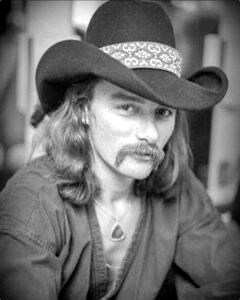
OBITUARY
Dickey Betts
12 December, 1943 – 18 April, 2024

He left home at 16 to join the circus and became a renowned guitarist touring the world with the Allman Brothers Band. He wrote the group’s biggest hit, “Ramblin’ Man,” and remained on the road until he reached the Rock & Roll Hall of Fame.
Betts shared lead guitar duties with Duane Allman in the original Allman Brothers Band to help give the group its unique sound and create a new genre, Southern rock. The band blended blues, country, R&B and jazz with ’60s rock to produce a distinct sound that influenced a host of major acts, including Lynyrd Skynyrd, ZZ Top, Phish, Jason Isbell and Chris Stapleton, among many others.
Founded in 1969, the Allmans were a pioneering jam band, trampling the traditional formula of three-minute pop songs by performing lengthy compositions in concert and on record. The band was also notable as a biracial group from the Deep South.
Duane Allman died in a motorcycle accident in 1971, and Berry Oakley was killed in a motorcycle crash the following year. That left Betts and Allman’s younger brother, Gregg, as the band’s leaders, but they frequently clashed, and substance abuse caused further dysfunction. The band broke up at least twice before reforming, and has had more than a dozen lineups.
The Allman Brothers Band was inducted into the Rock & Roll Hall of Fame in 1995 and earned a Lifetime Achievement Grammy Award in 2012. Betts left the group for good in 2000. He also played solo and with his own band Great Southern, which included his son, guitarist Duane Betts.
Forrest Richard Betts was born Dec. 12, 1943, and raised in the Bradenton, Florida, area, near the highway 41 he sang about in “Ramblin’ Man.” His family had lived in area since the mid-19th century.
A descendant of Canadian fiddlers, Betts was listening to string bands before he even started school. He developed a fondness for country, bluegrass and Western swing, and played the ukulele and banjo before focusing on the electric guitar because it impressed girls. But he usually did his songwriting on an acoustic guitar.
Betts changed schools often because his father worked construction, and those memories later inspired him to write “Ramblin’ Man.” His first big road trip came when he joined the circus to play in a band.
He returned home, and with Oakley joined a group that became the Jacksonville, Florida-based band Second Coming. One night in 1969, Betts and Oakley jammed with Duane Allman, already a successful session musician, and his younger brother. Together they formed the Allman Brothers Band.
Betts “excelled at anything that caught his attention,” according to a statement posted Thursday on the Allman Brothers Band's official website. “He was passionate in life, be it music, songwriting, fishing, hunting, boating, golf, karate or boxing.”
The group moved to Macon, Georgia, and released a self-titled debut album in 1969. A year later came the album “Idlewild South,” highlighted by Betts’ instrumental composition “In Memory of Elizabeth Reed,” which soon became a concert favorite.
The 1971 double album “At Fillmore East,” now considered among the greatest live albums of the classic rock era, was the Allmans’ commercial breakthrough and cemented their performing reputation by showcasing the unique guitar interplay between Allman and Betts. Their styles contrasted, with Allman playing bluesy slide guitar, while Betts’ solos and singing tugged the band toward country. When layered in harmony, their playing was especially distinctive.
The group also had two drummers — Butch Trucks and John Lee “Jaimoe” Johanson, a Black musician from Mississippi who helped integrate Southern rock.
Duane Allman died four days after “Fillmore” was certified as a gold record, but the band carried on and crowds continued to grow. The 1973 album “Brothers and Sisters” rose to No. 1 on the charts and featured “Ramblin’ Man,” with Betts singing the lead and bringing twang to the Top 40. The song’s intro suggested a fiddle tune, while the coda was inspired by Derek and the Dominos’ “Layla,” an earlier hit that had featured Duane Allman.
“Ramblin’ Man” reached No. 2 on the singles charts and was kept out of the No. 1 spot by “Half Breed” by Cher, who later married Gregg Allman. Betts’ composition became a classic-rock standard, with his soaring guitar reverberating in neighborhood bars around the country for decades.
“Ramblin’ Man” was the Allmans’ only Top Ten hit, but Betts’ catchy 7 ½-minute instrumental composition “Jessica,” recorded in 1972, also showed his knack for melodic hooks and became an FM radio staple. Painstaking in his approach to songwriting, Betts spent two months composing “Jessica,” which was inspired by the music of jazz guitar great Django Reinhardt.
Betts also wrote or co-wrote some of the Allmans’ other best-loved songs, including “Blue Sky” and “Southbound.”
Dormant for most of the 1980s, the Allman Brothers Band launched a comeback in 1990 with Warren Haynes joining Betts on guitar.
Betts recorded three more studio albums and toured with the band over the next decade, but he had an acrimonious split from the Allman Brothers in 2000.
After leaving the Allmans for good, Betts continued to play with his own group and lived in the Bradenton area with his wife, Donna.
Show your support
Add a Memory
Share Obituary
Get Reminders
Services
SHARE OBITUARYSHARE
- GET REMINDERS
v.1.16.0